 TravelINDIA.COM
TravelINDIA.COM
Ladakh
The land of high passes
home page
Ladakh is a region in the Indian state of Jammu and Kashmir that currently extends from the Kunlun mountain range to the main Great Himalayas
to the south, inhabited by people of Indo-Aryan and Tibetan descent. It is one of the most sparsely populated regions in Jammu and Kashmir and its culture and
history are closely related to that of Tibet. Ladakh is renowned for its remote mountain beauty and culture.
Historically, the region included the Baltistan (Baltiyul) valleys (now mostly in Pakistan), the entire upper Indus Valley, the remote Zanskar, Lahaul and Spiti to
the south, much of Ngari including the Rudok region and Guge in the east, Aksai Chin in the northeast (extending to the Kun Lun Mountains), and the Nubra Valley to
the north over Khardong La in the Ladakh Range. Contemporary Ladakh borders Tibet to the east, the Lahaul and Spiti regions to the south, the Vale of Kashmir, Jammu
and Baltiyul regions to the west, and the southwest corner of Xinjiang across the Karakoram Pass in the far north.
Aksai Chin is one of the disputed border areas between China and India. It is administered by China as part of Hotan County but is also claimed by India as a part of
the Ladakh region of the state of Jammu and Kashmir. In 1962, China and India fought a brief war over Aksai Chin and Arunachal Pradesh, but in 1993 and 1996 the two
countries signed agreements to respect the Line of Actual Control.
In the past Ladakh gained importance from its strategic location at the crossroads of important trade routes, but since the Chinese authorities closed the borders
with Tibet and Central Asia in the 1960s, international trade has dwindled except for tourism. Since 1974, the Government of India has successfully encouraged
tourism in Ladakh. Since Ladakh is a part of strategically important Jammu and Kashmir, the Indian military maintains a strong presence in the region.
The largest town in Ladakh is Leh, followed by Kargil. Almost half of Ladakhis are Shia Muslims and the rest are mostly Tibetan Buddhists. Some Ladakhi activists
have in recent times called for Ladakh to be constituted as a union territory because of perceived unfair treatment by Kashmir and Ladakh's cultural differences with
predominantly Muslim Kashmi
History
Ancient history
Rock carvings found in many parts of Ladakh indicate that the area has been inhabited from Neolithic times. Ladakh's earliest inhabitants consisted of a mixed
Indo-Aryan population of Mons and Dards, who find mention in the works of Herodotus, Nearchus, Megasthenes, Pliny, Ptolemy, and the geographical lists of the Puranas.
Around the 1st century, Ladakh was a part of the Kushan Empire. Buddhism spread into western Ladakh from Kashmir in the 2nd century when much of eastern Ladakh and
western Tibet was still practicing the Bon religion. The 7th century Buddhist traveler Xuanzang describes the region in his accounts.
According to Rolf Alfred Stein, author of Tibetan Civilization, the area of Zhangzhung was not historically a part of Tibet and was a distinctly foreign territory to
the Tibetans.
Medieval history

Between the 1380s and early 1510s, many Islamic missionaries propagated Islam and proselytised the Ladakhi people. Sayyid Ali Hamadani, Sayyid Muhammad Nur Baksh
and Mir Shamsuddin Iraqi were three important Sufi missionaries who propagated Islam to the locals. Mir Sayyid Ali was the first one to make Muslim converts in
Ladakh and is often described as the founder of Islam in Ladakh. Several mosques were built in Ladakh during this period, including in Mulbhe, Padum and Shey, the
capital of Ladakh. His principal disciple, Sayyid Muhammad Nur Baksh also propagated Islam to Ladakhis and the Balti people rapidly converted to Islam.
Noorbakshia Islam is named after him and his followers are only found in Baltistan and Ladakh. During his youth, Sultan Zain-ul-Abidin expelled the mystic Sheikh
Zain Shahwalli for showing disrespect to him. The sheikh then went to Ladakh and proselytised many people to Islam. In 1505, Shamsuddin Iraqi, a noted Shia scholar,
visited Kashmir and Baltistan. He helped in spreading Shia Islam in Kashmir and converted the overwhelming majority of Muslims in Baltistan to his school of thought.
 It is unclear what happened to Islam after this period and it seems to have received a setback. Mirza Muhammad Haidar Dughlat who invaded and briefly conquered
Ladakh in 1532, 1545 and 1548, does not record any presence of Islam in Leh during his invasion although Shia Islam and Noorbakshia Islam continued to flourish in
other regions of Ladakh.
It is unclear what happened to Islam after this period and it seems to have received a setback. Mirza Muhammad Haidar Dughlat who invaded and briefly conquered
Ladakh in 1532, 1545 and 1548, does not record any presence of Islam in Leh during his invasion although Shia Islam and Noorbakshia Islam continued to flourish in
other regions of Ladakh.
Modern history
At the time of the partition of India in 1947, the Dogra ruler Maharaja Hari Singh signed the Instrument of Accession to India. Pakistani raiders had reached
Ladakh and military operations were initiated to evict them. The wartime conversion of the pony trail from Sonamarg to Zoji La by army engineers permitted tanks to
move up and successfully capture the pass. The advance continued. Dras, Kargil and Leh were liberated and Ladakh cleared of the infiltrators.
In 1949, China closed the border between Nubra and Xinjiang, blocking old trade routes. In 1955 China began to build roads connecting Xinjiang and Tibet through this
area. It also built the Karakoram highway jointly with Pakistan. India built the Srinagar-Leh Highway during this period, cutting the journey time between Srinagar
and Leh from 16 days to two. The route, however, remains closed during the winter months due to heavy snowfall. Construction of a 6.5 km tunnel across Zoji La pass
is under consideration to make the route functional throughout the year.
The Kargil War of 1999, codenamed "Operation Vijay" by the Indian Army, saw infiltration by Pakistani troops into parts of Western Ladakh, namely Kargil, Dras, Mushkoh, Batalik and Chorbatla, overlooking key locations on the Srinagar-Leh highway. Extensive operations were launched in high altitudes by the Indian Army with considerable artillery and air force support. Pakistani troops were evicted from the Indian side of the Line of Control which the Indian government ordered was to be respected and which was not crossed by Indian troops. The Indian government was criticized by the
Indian public because India respected geographical co-ordinates more than India's opponents: Pakistan and China.
Geography

Ladakh is the largest province within the North Indian State of Jammu and Kashmir, covering approximately 60,000
square miles (100,000 sq. km). It is surrounded and bisected by some of the highest mountain ranges in the world.
Ladakh GeographyRunning in a generally northwest to southeast direction through Ladakh, the great Himalayan Range separates the Vale of Kashmir from Ladakh. Further
east, and running in the same direction, the Zanskar Mountains enclose the Zanskar River Valley. Still further east is the Ladakh Range, forming the Indus River
Valley, while to the northeast the Karakorum Mountains for the eastern boundary of Nubra Valley. The height of these ranges prevents rain clouds from crossing into
Ladakh and as a result, Ladakh receives only about 2 inches (5 cm) of rain per year. The aridity of the area is immediately apparent to the visitor, with Ladakh's
long vistas of mountains without vegetation and valleys with only a few oases of green.
The Indus River runs through Ladakh and the 30-mile (50 km) stretch of the Indus River Valley between Spitok gompa (near Leh airport) and Hemis gompa is the
heartland of Ladakh. Here are scattered some of the finest gompas in the region and here also is the town of Leh, the capital of Ladakh. The valley lies at an
altitude of about 11,350 feet (3,500 m) and some of the surrounding peaks reach heights of 22,500 feet (7,000 m).
Culture
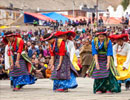
Music and dance
Traditional music includes the instruments surna and daman (shenai and drum). The music of Ladakhi Buddhist monastic festivals, like Tibetan music, often involves
religious chanting in Tibetan as an integral part of the religion. These chants are complex, often recitations of sacred texts or in celebration of various festivals.
Yang chanting, performed without metrical timing, is accompanied by resonant drums and low, sustained syllables. Religious mask dances are an important part of Ladakh's
cultural life. Hemis monastery, a leading centre of the Drukpa tradition of Buddhism, holds an annual masked dance festival, as do all major Ladakhi monasteries. The
dances typically narrate a story of the fight between good and evil, ending with the eventual victory of the former. Weaving is an important part of traditional life
in eastern Ladakh. Both women and men weave, on different looms. Typical costumes include gonchas of velvet, elaborately embroidered waistcoats and boots and hats.
Sports
The most popular sport in Ladakh is ice hockey, which is played only on natural ice generally mid-December through mid-February. Cricket is also very popular.
Archery is a traditional sport in Ladakh, and many villages hold archery festivals, which are as much about traditional dancing, drinking and gambling, as they are
about the sport. The sport is conducted with strict etiquette, to the accompaniment of the music of surna and daman (shehnai and drum). Polo, the other traditional
sport of Ladakh, is indigenous to Baltistan and Gilgit, and was probably introduced into Ladakh in the mid-17th century by King Singge Namgyal, whose mother was a
Balti princess.
Polo, popular among the Baltis, is an annual affair in Drass region of District Kargil.
Traditional medicine
Tibetan medicine has been the traditional health system of Ladakh for over a thousand years. This school of traditional healing contains elements of Ayurveda and
Chinese medicine, combined with the philosophy and cosmology of Tibetan Buddhism. For centuries, the only medical system accessible to the people have been the
amchi, traditional doctors following the Tibetan medical tradition. Amchi medicine remains a component of public health, especially in remote areas.
Programmes by the government, local and international organisations are working to develop and rejuvenate this traditional system of healing. Efforts are underway to
preserve the intellectual property rights of amchi medicine for the people of Ladakh. The government has also been trying to promote the sea buckthorn in the form of
juice and jam, as some claim it possess medicinal properties.
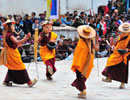
Festivals
Ladakh celebrates many famous festivals. One of the biggest and most popular is the Hemis festival. It is celebrated in June to commemorate the birth of Guru Padmasambhava.
In September, the Jammu and Kashmir Tourism Department with the help of local authorities organize the Ladakh Festival. The Government of Jammu and Kashmir organizes the Sindhu
Darshan festival at Leh in May–June. It is celebrated on the full moon day (Guru Poornima)
climate
The desert type of climate is typical of Leh Ladakh with dry winds blowing throughout the day and summers being hot and humid. On your visit to Leh, you will face
the cold desert climate, especially from October to March. In winters the temperatures are extreme in Leh, dipping below freezing point. However, winter days are
sunny and bright. The lowest winter temperature recorded in Leh is around minus 23 degree Celsius. Mountaineers and trekkers enjoy the climate of Leh Ladakh to the
fullest! Considering the extremities that you face here, make sure to carry winter shields, woolen wear and snow boots. During the months of December and January the
inflow of tourist is comparatively low.
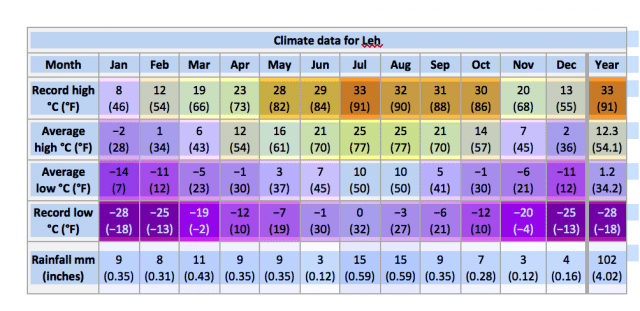
Tourism

LEH PALACE
The grand royal palace of Leh overlooks the Namgyal hill lying atop the old Leh city. Snuggled in the lap of beautiful landscapes, the Palace is a popular tourist
destination in Leh. The important hub of Buddhist culture and religion provides spectacular views. A statue of Lord Buddha graces the monastery of the palace. Old
pictures and paintings are displayed in the exhibition halls of the palace, which include Tibetan thangka and other artistic paintings. Paintings that are over 450
years old are housed here. Some of these fine specimens were created using colors derived from powdered stones and gems. Till date these paintings retain their rich
and vivid appearance. The Leh palace treasures a rich collection of crowns, ceremonial dresses and jewellery among others.

STOK PALACE
Stok Palace, built by King Tsespal Tondup Namgyal in 1825, in the present times is the residential palace of the royal descendants of King Sengge Namgyal. The
architecture of this palace is a perfect mix of the traditional and the contemporary architectural styles. This palatial property consists of a number of beautiful
gardens as well as a library that has around 108 volumes of the Kangyur (a collection of teachings of Lord Buddha). The palace is located around 15 kms away from
the main city of Leh.
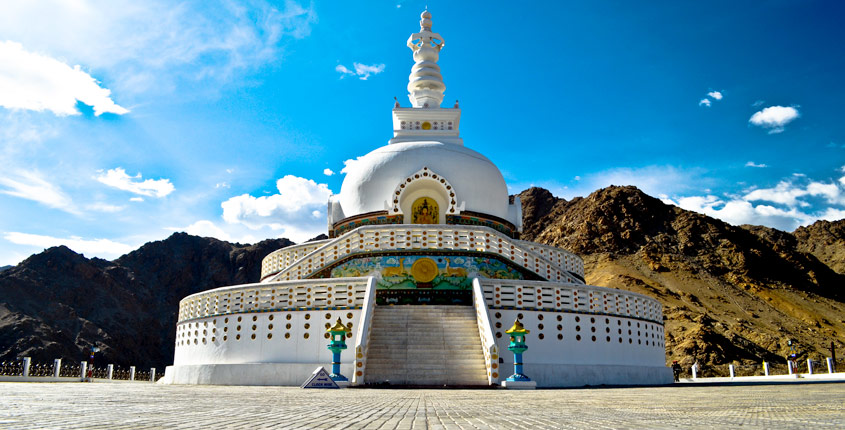
SHANTI STUPA
The Shanti Stupa is white-colored domed-shaped structure, located in Chandspa which looks extremely beautiful during night when it is illuminated. This peace
pillar was built a ‘peace sect’ of Japanese Buddhist organization to celebrate the completion of 2500 years of Buddhism and for the promotion of world peace. It
was inaugurated by His Holiness, the Dalai Lama in 1985. This pillar is known for its gilt panels depicting the life stories of Lord Buddha. It is just 5 kms away
from the main city of Leh and is surrounded the traditionally built houses of the locals and snow-covered mountains. Take the steep slights to reach the Stupa that
offers beautiful sunrise and sunset views.
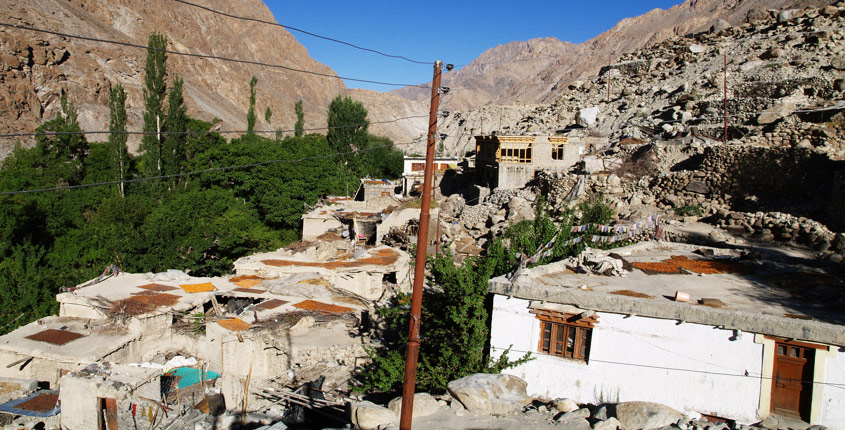
DHA AND HANU
Located around 163 km north-west of the town of Leh, the village settlements of Dha and Hanu are placed on the meeting points of Indus and Shyok Rivers in the Kargil region. Famed as the ‘Land of Aryans’, these villages are home to Brokpa or Drokpa community of Ladakh. The Brokpas have made around 5 villages their home but the tourists are permitted to visit
only villages- Dha and Hanu. Apart from tourists, these villages are an attraction for anthropologists also.
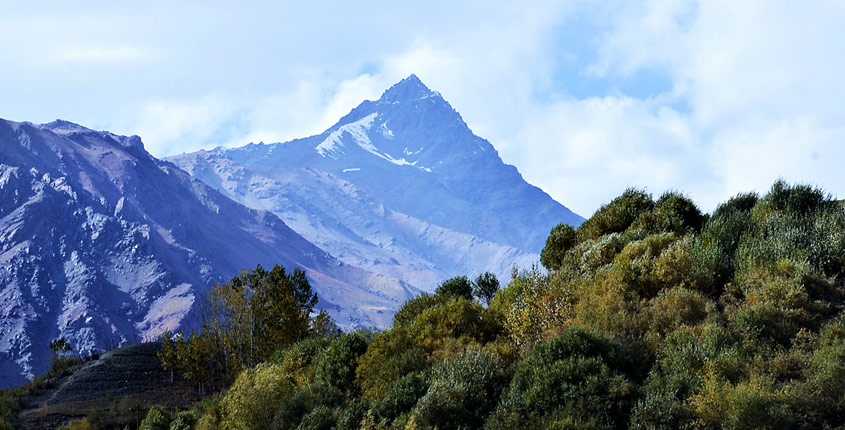
TIGER HILL
Placed at an elevation of 5,353meters, Tiger Hill in Drass Valley is is a strategically important mountain peak overlooking National Highway 1D, serving as a gateway to Siachen Glacier and connecting Leh to Srinagar.
Tiger Hill shot into prominence after the major battle took place to take back the peak from the Pakistani Army who captured it in 1999. In fact, the battle for recapture of Tiger Hill or the ‘Point 4660’ is considered to be one of
the most important battles waged by the Indian army against the Pakistani army during the Kargil War in 1999
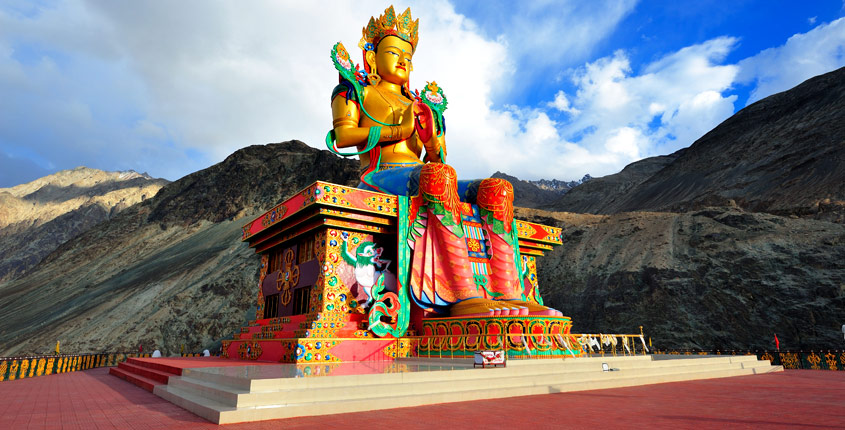
MAITREYA BUDDHA
Close to the oldest monastery of Nubra valley in Ladakh, Diskit monastery, lies the impressive statue of Jampa Buddha. Along the other attractions of Nubra, this
mighty Buddha statue surmounted on top of a monastery, is one of the prime and is deeply appreciated for its architecture. Facing the Shyok river, the statue sits
tall with a height of 32 meters and was constructed with the help of the natives of the valley.
Gold to be used in the construction of the statue was donated by the heads of other major monasteries
around. The idea behind the construction of Maitreya Buddha is to promote peace and protection in the region.
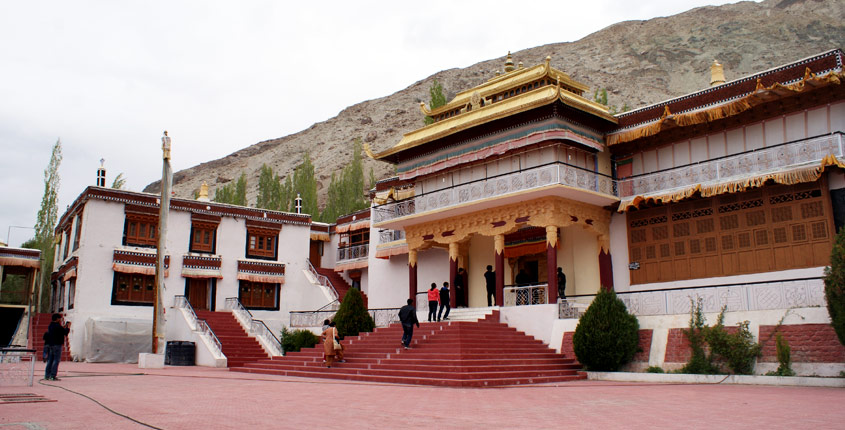
SAMSTANLING MONASTERY
Placed in the Sumlur village of the Nubra valley region, Samstanling Monastery was founded 140 years back in 1841 by Lama Tsultim Nima. The Monastery is 124 km from Leh and serves to more than 50 monks with the daily needs. The place is to be found
in the middle of pleasant scenic beauty and is surrounded by traditional hues of Gold, Red Ocher and white.
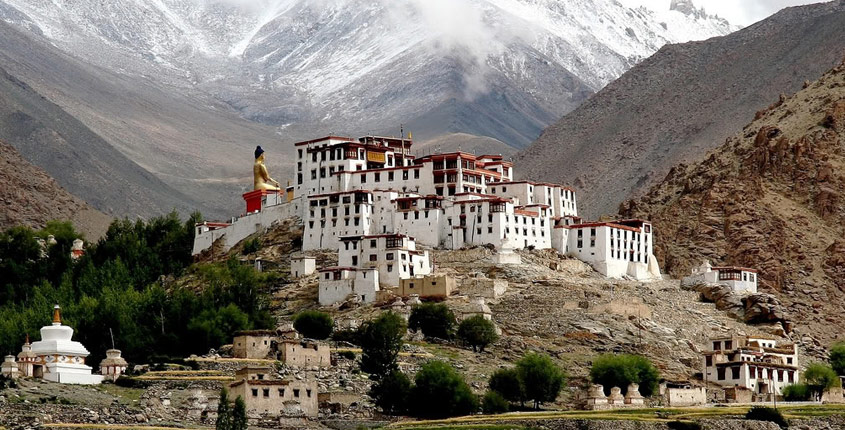
LIKIR GOMPA
Likir Gompa, around 62 kms to the West of the main city of Leh. The 5th king of Ladakh, Lhachen Gyalpo ordered the establishment of this monastery and thus it was established in 1065 by Lama Duwang Chosje. The monastery is of the Gelugpa sect of Tibetan Buddhism. In
the times of today, Buddhist teachings and the three basic Pratimoksa disciplines are preached on the site.
Transportation
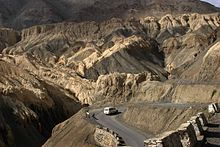
Road
There are about 1,800 km (1,100 mi) of roads in Ladakh of which 800 km (500 mi) are surfaced.
The majority of roads in Ladakh are looked after by the Border Roads Organisation.
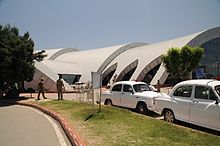
Air
There is one airport in Leh, from which there are daily flights to Delhi and weekly flights to Srinagar and Jammu. There are two airstrips at Daulat Beg Oldie and
Fukche for military transport. While an airport meant for civilian purpose at Kargil is used by the Indian Army. The airport is a political issue for the locals
who argue that the airport should serve its original purpose, i.e., should open up for civilian flights. Since past few years the Indian Air Force has been operating
AN-32 air courier service to transport the locals during the winter seasons to Jammu, Srinagar and Chandigarh. A private airplane company Air Mantra landed a
17-seater aircraft at the airport, in presence of dignitaries like the Chief Minister Omar Abdullah, marking the first ever landing by a civilian airline company at
Kargil.
 It is unclear what happened to Islam after this period and it seems to have received a setback. Mirza Muhammad Haidar Dughlat who invaded and briefly conquered
Ladakh in 1532, 1545 and 1548, does not record any presence of Islam in Leh during his invasion although Shia Islam and Noorbakshia Islam continued to flourish in
other regions of Ladakh.
It is unclear what happened to Islam after this period and it seems to have received a setback. Mirza Muhammad Haidar Dughlat who invaded and briefly conquered
Ladakh in 1532, 1545 and 1548, does not record any presence of Islam in Leh during his invasion although Shia Islam and Noorbakshia Islam continued to flourish in
other regions of Ladakh.














